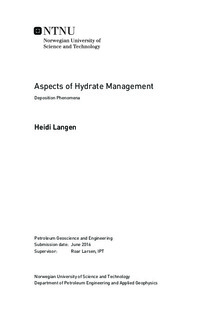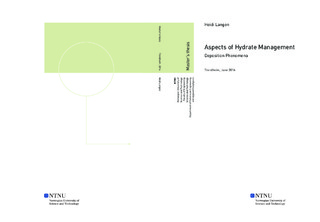| dc.description.abstract | The purpose of this thesis has been to investigate the factors with the largest influence on the adhesion strength of a hydrate deposit on a solid surface. This has been done through a literature study on the subject, and a thorough experimental project in a laboratory. The experiments involved forming hydrate deposits on a pipe of steel, before removing the deposits and finding the pressure required to do so. The hydrate was formed by a solution of tetrahydrofuran and water in a tank where the pipe was submerged. The system achieved hydrate-forming conditions by flowing cold fluid through the pipe. After hydrate had deposited at the pipe surface, it was first left to grow for a certain time before a scraping device was pushed down the outside of the pipe with the use of a pump attached to a piston. The scraper removed some of the hydrate deposit, and a manometer measured the pressure provided by the pump at this point.
The experiments involved five different cases; one with ice deposits and four with hydrate. The one with ice was performed by using a pipe with relatively high surface roughness. The four hydrate cases involved one with the same high roughness pipe, one with a smoother pipe, one with the rough pipe coated with automotive paint and the last was with the smooth pipe coated with a primer originally used to avoid corrosion. Each case was tested at two temperatures and three to four different no-touch times. The parameters tested in the lab were temperature, growth time of the hydrate layer (no-touch time), thickness of the layer and the surface roughness of the solid surface. The last two parameters were found to have the largest impact, but the two others also had some significance. The lowest tested temperatures gave higher pressure readings than the ones with high temperature. A smooth surface resulted in lower adhesion than when the roughness was higher. The thickness of the deposit had a close to proportional relationship with the pressure, i.e. a thick layer resulted in strong adhesion to the surface. Thick layers usually occurred at long no-touch times, meaning that the longest no-touch times also gave strong adhesion. | |

